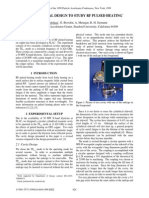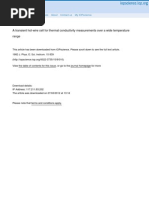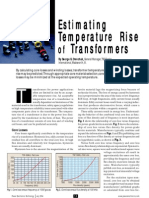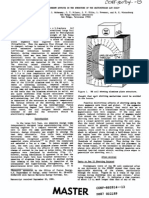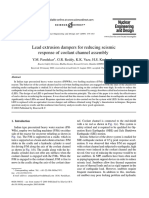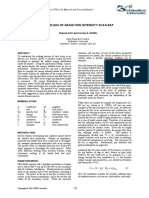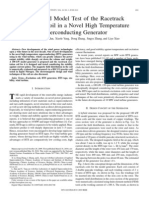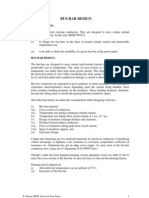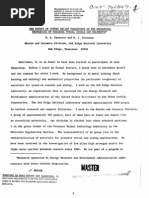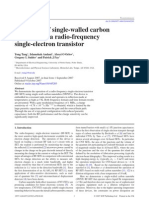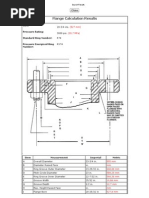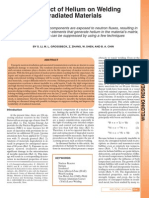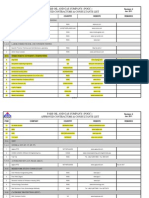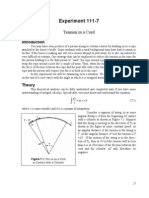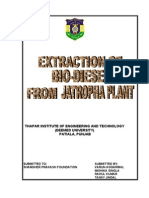Preliminary Design of A Stainless Steel Helium Tank and Its Associated Cold Tuning System For 700 MHZ SCRF Cavities For Proton
Preliminary Design of A Stainless Steel Helium Tank and Its Associated Cold Tuning System For 700 MHZ SCRF Cavities For Proton
Uploaded by
kaveh-bahiraeeCopyright:
Available Formats
Preliminary Design of A Stainless Steel Helium Tank and Its Associated Cold Tuning System For 700 MHZ SCRF Cavities For Proton
Preliminary Design of A Stainless Steel Helium Tank and Its Associated Cold Tuning System For 700 MHZ SCRF Cavities For Proton
Uploaded by
kaveh-bahiraeeOriginal Description:
Original Title
Copyright
Available Formats
Share this document
Did you find this document useful?
Is this content inappropriate?
Copyright:
Available Formats
Preliminary Design of A Stainless Steel Helium Tank and Its Associated Cold Tuning System For 700 MHZ SCRF Cavities For Proton
Preliminary Design of A Stainless Steel Helium Tank and Its Associated Cold Tuning System For 700 MHZ SCRF Cavities For Proton
Uploaded by
kaveh-bahiraeeCopyright:
Available Formats
The 10 th Workshop on RF Superconductivity, 2001, Tsukuba, Japan
PRELIMINARY DESIGN OF A STAINLESS STEEL HELIUM TANK AND ITS ASSOCIATED COLD TUNING SYSTEM FOR 700 MHZ SCRF CAVITIES FOR PROTON.
H. Saugnac, S. Rousselot, C. Commeaux, H. Gassot, T. Junquera, Institut de Physique Nuclaire Orsay, 91406 cedex, France P. Bosland, H. Safa, CEA Saclay/DAPNIA/SEA, Gif-sur-Yvette, 91191 cedex, France Abstract
For the R&D program on 700 MHz SCRF cavities for proton, we study the helium tank attached to a 5-cells cavity and its cold tuning system. Our work is orientated to a stainless steel helium tank, mainly for cost reduction. We present in this paper preliminary tests and results giving good arguments on the feasibility of a stainless steel helium tank brazed on the cavity cut off. Then we describe the helium tank design and the mechanical cold tuning system based on the Soleil principle designed at CEA Saclay. either great thermal stresses on the cavity, either a large stroke for the CTS. Further more the technological feasibility of this solution remains to be proven. The paper describes preliminary tests on the feasibility of a SS helium tank, the design of the helium tank and the Cold tuning system.
2 PRELIMINARY TESTS
Brazing a stainless steel helium tank on the niobium cavity cut off stands several technological difficulties. A first optimistic foreground was given by the CERCA French company who brazed with copper stainless steel CF flanges on some cavities cut off of the former APT project. Several tests and simulations were performed on various technological aspects and consequences of using SS helium tank. In the case of the helium tank, super fluid helium is directly in contact with the brazed interface which would emphasis the gaseous flux inside the cryostat insulation vacuum in case of leaks. This risk of leak is improved by the great thermal hoop stresses taking place at cool down between SS and Niobium. A first experiment was stand to verify the tightness of the brazing on a mock up at super fluid helium.
Niobium Ep 4.2 mm 304 L
1 INTRODUCTION
The purpose of the paper concerns the whole mechanical structure composed by the cavity, the helium tank and the cold tuning system (CTS). These elements, as shown below, are strongly connected in term of mechanical design as the helium tank gives, associated with the cold tuning system (CTS) , a parallel stiffness to the cavity. This stiffness is linked to several cavity characteristics as cavity stiffness, static Lorentz forces and the CTS stiffness and mechanical resolution.
Cold tuning system Helium tank
Stepping motor
Decoupling bellow
77.8
120
Figure 1 Principle layout of the cavity cold tuning The compensating bellow, decouples the cavity to the rest of the structure allowing the CTS to pull or push the cavity. Therefore the frequency shift caused by the lorentz longitudinal component forces depends on the stiffness of the CTS/Helium tank ensemble. In our case the use of Stainless Steel (SS), instead of titanium, for the helium tank and the CTS reduces considerably the manufacturing costs. The draw back is
Figure 2 Niobium / SS Mock-up This mock up consists in a Niobium tube where stainless flanges are brazed at extremities. There is similarity of the maximal thermal stresses at the brazing area between the mock up and the final design of the tank which are respectively about 150, 80, 60 N/mm2 for the Niobium tube, the copper interface (70 m thick) and the SS flange.
540
The 10 th Workshop on RF Superconductivity, 2001, Tsukuba, Japan
An additional longitudinal load of about 5000 N for each flanges was added to simulate forces generated by the CTS. No leak at 2 K was detected, after 10 thermal cycles at 80 K, with a sensibility better than 2 10-9 mbar l/s. Even if the EB welding heats locally the bounded parts we may have over heating in a small area. In our case, on the main coupler side the brazed helium tank is close to the EB welding of the first cavity Iris. Risks of migration and diffusion of copper may occur. It effects pollution of the RF surfaces or the EB welding itself causing leaks. Samples were analysed for different distance between the copper brazed interface and the EB welding. Conclusions were that the diffusion is negligible but for distances about 3-4 mm the copper is melt and may flow toward the EB welding area. A minimal distance of 9 mm, taking into account the tests samples and thermal simulations, was chosen for the design of the tank Effects of the residual magnetic field in stainless steel is to be tested in the CRYHOLAB horizontal cryostat with a first 700 MHz mono-cell (fig. 3) equipped with its whole SS helium tank. A first test of this mono-cell equipped with only its 316 LN extremity caps has been performed in a vertical cryostat and shows very good RF performances (Q0 ~ 4 1010, 25 MV/m before quench).
3.1
Cavity tuning parameters
The parameters presented below were calculated for a 5 cell 700 MHz cavity [1]. Longitudinal frequency sensitivity ~ 250 kHz/mm f/l ~ 1592 N/mm Longitudinal cavity stiffness F/l Band width for Ip ~ 20 mA ~ 500 Hz f 13.86 N Static longitudinal Lorentz Force F Lorentz Thermal differential contraction ~ 1.6 mm/m @ 4 K L Helium Tank L cavity Frequency shift due to cool down To be measured f CD ~ 300 kHz Incertainity on f CD Arbitrarily set !! CD Table 1 : Cavity tuning parameters Several design numbers can be evaluated : - The mechanical resolution of the CTS is taken as
25 f = 25 Hz > 0.1m f 20 l
- The frequency shift caused by the static lorentz force must be inside the bandwidth. It means that the stiffness of the Helium tank CTS ensemble should be : F f K tan k + CTS > Lorentz 7000 N / mm l f - When acting the CTS a part of the deformation goes to the helium tank and the CTS parts. We want to have 90 % at least of the CTS displacement going to the cavity : F l > 15000 N / mm K
tan k + CTS
Figure 3 700 MHz mono cell w. SS helium tank end caps
90%
3 MECHANICAL TUNING
As said above the CTS and helium tank designs are subjected to cavity mechanical parameters. This parameters are also needed to set up the fundamental frequency the cavity must have before cool down.
- The design value taken for the helium tank / CTS stiffness is k tan k / SAF 20000 N / mm
3.2
Warm frequency
The different fabrication steps of the cavity modify its fundamental frequency [2] ( fabrication incertainities, chemical preparation). The warm tuning ( field flatness adjustment ) being the last process affecting the cavity shape is used to adjust the frequency to the good value. This value is connected to the frequency shift during cool down and the maximal range of the CTS. The CTS can operate in only one direction (pulling or pushing) to avoid discontinuity of the motors steps
541
The 10 th Workshop on RF Superconductivity, 2001, Tsukuba, Japan
/cavity deformation relation due to backlash in the CTS mechanical parts. Assuming this we can give the relation between the warm frequency before cool down and the maximal range of the CTS. Two cases are possible. Case 1 The cold tuning system is attached to the cavity and the helium tank. At 2 K the cavity is compressed by 1.6 mm/m. The target frequency f0 must be outside the cold frequency band
f C CD 2
The CTS is not attached to the cavity during cool down. The cavity contracts freely at 2 K and receive no thermal stresses. fW fC f0
to avoid the CTS to act either by f CD CD/2 CD/2 f Lorentz
pushing or pulling on the cavity. In this case the CTS only stretch the cavity. fW corresponds to a pre stress applied at 300 K by the CTS to limit the compression stress on the cavity at 2 K. The warm frequency before cool down is then :
f w = f 0 ( f CD + CD 2 f + ( l tan k l cav ) l
+ f Lorentz ) fW
Figure 4 Frequency history during cool down-case 2
f w = f 0 ( f CD + CD + f Lorentz ) 2
Maximal cavity elongation : ( CD + f Lorentz ) compression :
l < 1.3mm f
Maximal
lTank lcav f w
cavity
l < 1.6mm f
Here the CTS must recover the differential thermal contraction between the tank and the cavity before stretching the cavity to its target frequency. Its maximal range is then :
( CD + f Lorentz ) l + lTank lcav < 3mm f
Maximal tuner range : ( CD + f Lorentz )
l < 1.3mm f
This case facilitate the fixture conception of the CTS on the rest of the structure but high stresses may appear on the cavity walls (~ 25 N/mm2) and on the CTS. The reproducibility of the frequency after cool down depends here on the dimensional tolerance of the CTS which would cause more scattering from one equipped cavity to the other. On the other hand the stroke of the CTS is low, about 1.3 mm. CASE 2
For this case the structure receive no longitudinal thermal stress and the cold frequency fC depends only on the cavities shape dispersion. The back draw is the more complicated conception of the CTS fixture and a greater required stroke.
4 HELIUM TANK DESIGN
The helium tank [3] plays the role of a cryogenic fluid container as well as a stiff mechanical structure. The
5 2 1 4 6
3 7
Figure 5 Helium tank design
542
The 10 th Workshop on RF Superconductivity, 2001, Tsukuba, Japan
design presented below is for a 700 MHz = 0.65 5 cell cavity being currently manufactured. The extremities, normalised 3 mm thick and 400 mm diameter domed cups (1), give a better stiffness than conical ends. For a load applied on the beam tube the longitudinal stiffness can reach about 55 kN/mm, which gives, associated with the cylindrical part of the vessel a total stiffness of about 50 kN/mm. The SS parts (2) are brazed on the Niobium cut off at a minimal distance of 9 mm from the nearest EB welds. The thickness of these rings is 15 mm to reduce the hoop thermal stresses at the copper interface without over stressing the niobium tube . The de coupling bellow (3) allows 6 mm displacement. Four supports (4) are welded close to the external diameter of the cups (where the tank stiffness is higher ) to fix the CTS. The vessel (5), 400 mm diameter, is as close as possible to the cavity equators to limit the volume available for helium inventory. A 40 mm CF cryogenic port onto the tank (6) is used for the feeding of super fluid helium from an auxiliary pot. Two 16 mm CF ports (7, 8) at the bottom of the tank are respectively dedicated to the cool down of the cavity and the relation to the auxiliary pot for LHe level measurements.
Figure 6 CTS Principle layout We also give us the ability to insert in this system piezo electric actuators to achieve finer resolution and dynamic tuning for possible pulsed beam operations. The CTS principle used was designed at CEA Saclay for the SOLEIL project [4]. It is typically constituted of a cold stepping motor (1) with 200 steps by turn associated with a gear reduction of ratio r = 1 : 50 . The engine torque and rotation (Cm and m) are transmitted to a screw /bolt mechanism (2) with a thread p. The two arms (3) rotate around the axis (4), loading symmetrically the beam tube flange (8) and the helium tank (7) with eccentric rods (6). The lever arm has a ratio h given by the length of the arms (3) and the eccentricity of the rods (6) : h=D/d. The cinematic and static relations are : 2 p h r Cm dxCTS = m and FCTS = p r 2h and : dxcav = dxCTS FCTS
1 kCTS / tan k
5 COLD TUNING SYSTEM DESIGN
We designed a CTS able to work in the case 2 mechanical tuning seen above. This involves a great stroke which is not incompatible with the rather high mechanical resolution required. Therefore a mechanical system with rolls compatible with vacuum and cryogenic temperature has been chosen.
Possible position of piezo actuators Helium tank Stepping motor & gear reduction
6 4 6 1 3 5 4 3 6 2
Lever arm mechanism
Screw
Figure 7 CTS design
543
The 10 th Workshop on RF Superconductivity, 2001, Tsukuba, Japan
The theoretical mechanical resolution is then : p rs < min i r 2h The lever arm ratio has been taken to 10 mainly to limit the load (about 600 N max.) on the screw/bolt mechanism which is the weak part in term of friction and wear. It leads to a designed resolution of about 25 nm. The designed CTS longitudinal stiffness is about 35kN/mm, which leads to an overall stiffness of the CTS/helium tank structure of 20kN/mm. As the cavity contracts freely the CTS will receive no tensile stresses during the cool down of the structure. Further more the pressure loads on the CTS occurring during the cryogenic processing are limited by the stiffness of domed cup and the use of a small diameter compensating bellow. Therefore It makes possible the insertion of piezo actuator with few tensile loads and no sensible stress induced loss of stroke. These piezo would be used as well as sensors, to validate simulations of dynamic Lorentz forces effects in pulsed mode and measure external vibration disturbances, and actuator to perform fast fine tuning and dynamic compensation of the frequency shifts.
6 SUMMARY
The design of a 5 cell = 0.65 700 MHz SCRF cavity helium tank and its associated Cold Tuning System have been described. The feasibility of the use of Stainless Steel for the helium tank is to be proven with the test of an equipped mono cell in the horizontal CRYHOLAB cryostat before the end of the year. In parallel the CTS is to be manufactured and efforts on the characterization and use of piezo actuators at 2 K are performed.
7 REFERENCES
[1] Effets des forces de Lorentz et systeme daccord en frquence pour des cavits proton rapport IPNO : H.Gassot, H.Saugnac, T. Junquera, JL. Biarrotte [2] TESLA Test Facility : Cold Tuning System TESLA Report : Ph. Leconte, O. Clou, J. Gastebois, M. Maurier [3] TESLA Test Facility : Helium Tank TESLA Report : Ph. Leconte, R. Duthil, M. Maurier [4] Principe du systeme daccord des cavits SOLEIL CE Saclay internal Report : P. Bosland, M. Juillard, M. Maurier, A. Mosnier, G. Perilhous
544
You might also like
- Assignment 2 ME-241Document6 pagesAssignment 2 ME-241Naman KansalNo ratings yet
- Auto-Transformer Design - A Practical Handbook for Manufacturers, Contractors and WiremenFrom EverandAuto-Transformer Design - A Practical Handbook for Manufacturers, Contractors and WiremenRating: 4 out of 5 stars4/5 (2)
- BS en 10028-3-2017Document22 pagesBS en 10028-3-2017Ly Khoa100% (1)
- Sprayidea 99 Embroidery Spray Adhesive MSDSDocument10 pagesSprayidea 99 Embroidery Spray Adhesive MSDSDishen SoobenNo ratings yet
- Optimal Design of A High Power High Frequency TransformerDocument10 pagesOptimal Design of A High Power High Frequency TransformerPablo KuziwNo ratings yet
- Fermilab Conf 13 138 TDDocument3 pagesFermilab Conf 13 138 TDAbhiruchi PatilNo ratings yet
- Experimental Design To Study RF Pulsed HeatingDocument3 pagesExperimental Design To Study RF Pulsed HeatingFarwin123No ratings yet
- Design Tube SheetsDocument3 pagesDesign Tube SheetsKarthik AnandanNo ratings yet
- Agitated Vessel Heat TransferDocument7 pagesAgitated Vessel Heat TransferalokbdasNo ratings yet
- Design, Development and Testing of Electrically Isolated Helium Feeds For Forced Flow Cooled Super-Conducting Magnet at 4.5 KDocument8 pagesDesign, Development and Testing of Electrically Isolated Helium Feeds For Forced Flow Cooled Super-Conducting Magnet at 4.5 KVinit MhatreNo ratings yet
- Bellows Design FEADocument9 pagesBellows Design FEAmatteo_1234No ratings yet
- Half CoilDocument6 pagesHalf Coilvaibhavd123No ratings yet
- Agitated Vessel Heat Transfer (K.J. Carpenter)Document9 pagesAgitated Vessel Heat Transfer (K.J. Carpenter)Clarence AG Yue100% (2)
- 2004 09 MedPhys - Schardt RotatingVesselXrayTube PDFDocument8 pages2004 09 MedPhys - Schardt RotatingVesselXrayTube PDFahmed_galal_waly1056No ratings yet
- Cooling& Heating Time CalculationDocument6 pagesCooling& Heating Time CalculationSandesh LawandNo ratings yet
- A Transient Hot-Wire Cell For Thermal Conductivity Measurements Over A Wide Temperature RangeDocument5 pagesA Transient Hot-Wire Cell For Thermal Conductivity Measurements Over A Wide Temperature RangeGeetha PookatNo ratings yet
- First Tests of Bi-Y T-FDocument8 pagesFirst Tests of Bi-Y T-FEBENo ratings yet
- Tugas Metalurgi Las - Heat Flow in WeldingDocument4 pagesTugas Metalurgi Las - Heat Flow in WeldingRhidiyan Waroko100% (4)
- Estimating Temperature Rise of Transformers Orenchak G. 2004)Document5 pagesEstimating Temperature Rise of Transformers Orenchak G. 2004)PL8ONo ratings yet
- G4 - Sample ExamsDocument8 pagesG4 - Sample ExamsLeeSM JacobNo ratings yet
- Pvp1996-Vol336 3Document4 pagesPvp1996-Vol336 3dogusNo ratings yet
- Thermal Design Consideration For Surface Mount LayoutsDocument16 pagesThermal Design Consideration For Surface Mount LayoutsRicardoNo ratings yet
- Master: Distribution of This Cnkuibeir Fs UkljmitedDocument5 pagesMaster: Distribution of This Cnkuibeir Fs UkljmitedJim Y. ParbaNo ratings yet
- Agitation UniformDocument4 pagesAgitation UniformMurat VarsatNo ratings yet
- Hy 3025Document7 pagesHy 3025davframNo ratings yet
- Lead Extrusion Dampers For Reducing SeismicDocument9 pagesLead Extrusion Dampers For Reducing Seismic文龙包No ratings yet
- Copper For Busbars-OrIENTAL CuDocument27 pagesCopper For Busbars-OrIENTAL Cutenk_man83% (6)
- Modeling of Radiation Intensity in An EAFDocument6 pagesModeling of Radiation Intensity in An EAFmehran1364No ratings yet
- Design and Model Test of The Racetrack Excitation Coil in A Novel High Temperature Superconducting GeneratorDocument4 pagesDesign and Model Test of The Racetrack Excitation Coil in A Novel High Temperature Superconducting GeneratorDuo ZhangNo ratings yet
- Crystal PrimerDocument16 pagesCrystal Primersm00th101No ratings yet
- A Sensitive Vibrating Sample MagnetometerDocument3 pagesA Sensitive Vibrating Sample Magnetometersoumendra ghoraiNo ratings yet
- Predicting Temperature Rise of Ferrite Cored TransformersDocument5 pagesPredicting Temperature Rise of Ferrite Cored TransformersPhạm Văn TưởngNo ratings yet
- Planar TransformerDocument16 pagesPlanar TransformerParag RekhiNo ratings yet
- Coolant Channel Life MGT - DNSDocument52 pagesCoolant Channel Life MGT - DNSVikas Kumar TiwariNo ratings yet
- Agitated Vessel Heat TransferDocument6 pagesAgitated Vessel Heat TransferkitofanecoNo ratings yet
- Bus Bar DesignDocument5 pagesBus Bar DesignRamadhar Sharma100% (1)
- Triodes For Very Short Waves OscillatorsDocument14 pagesTriodes For Very Short Waves OscillatorsriverajluizNo ratings yet
- ECTC-2009 Current CapacityDocument6 pagesECTC-2009 Current Capacityricha_newdelhiNo ratings yet
- Mech302-Heat Transfer Homework-7 SolutionsDocument8 pagesMech302-Heat Transfer Homework-7 SolutionsJake OkuyeNo ratings yet
- The Effect of Stress Relief Parameters On The Mechancial Properties of Pressure Vessel Steels and WeldmentsDocument17 pagesThe Effect of Stress Relief Parameters On The Mechancial Properties of Pressure Vessel Steels and Weldmentsm5416No ratings yet
- Cable Sizing PrincipleDocument7 pagesCable Sizing PrincipleYouwan LeeNo ratings yet
- Rossette 等。 - 2009 - The effect of start-up cycle in ceramic coating usDocument10 pagesRossette 等。 - 2009 - The effect of start-up cycle in ceramic coating usXin LiNo ratings yet
- Study On Free Standing 3C-SiCDocument6 pagesStudy On Free Standing 3C-SiCjiknuruydeNo ratings yet
- Concept of Design Cryogenic PipingDocument3 pagesConcept of Design Cryogenic PipingSiampol FeepakphorNo ratings yet
- Operation of Single-Walled Carbon Nanotube As A Radio-Frequency Single-Electron TransistorDocument5 pagesOperation of Single-Walled Carbon Nanotube As A Radio-Frequency Single-Electron TransistorNisha AgrawalNo ratings yet
- Heater 10m2 (ASME Tubesheet)Document17 pagesHeater 10m2 (ASME Tubesheet)Omil RastogiNo ratings yet
- 11.6 Longitudinal Finned Double-Pipe ExchangersDocument14 pages11.6 Longitudinal Finned Double-Pipe Exchangersvatsal07No ratings yet
- Nuclear Engineering and Design: Thermal Striping Limits For Components of Sodium Cooled Fast Spectrum ReactorsDocument12 pagesNuclear Engineering and Design: Thermal Striping Limits For Components of Sodium Cooled Fast Spectrum ReactorsjofredjosephNo ratings yet
- Presentation of The Electrical Molten Zone (EMZ) TechniqueDocument32 pagesPresentation of The Electrical Molten Zone (EMZ) TechniqueJohn HenrysNo ratings yet
- TafirifezaDocument2 pagesTafirifezazafrikhan875No ratings yet
- Med - 00000619 - 1193753698 - Quartz Crystal Theory 2007Document6 pagesMed - 00000619 - 1193753698 - Quartz Crystal Theory 2007haha2012No ratings yet
- Hts Song Presentation2011Document46 pagesHts Song Presentation2011Anonymous 8te2h1No ratings yet
- High PhaseDocument45 pagesHigh PhaseadnanNo ratings yet
- HT (Tute Sheets)Document8 pagesHT (Tute Sheets)Jagdeep PundirNo ratings yet
- Ceramic Materials for Energy Applications V: A Collection of Papers Presented at the 39th International Conference on Advanced Ceramics and CompositesFrom EverandCeramic Materials for Energy Applications V: A Collection of Papers Presented at the 39th International Conference on Advanced Ceramics and CompositesJosef MatyášNo ratings yet
- Electroplating for Amateurs: Classic Reference for Small WorkshopsFrom EverandElectroplating for Amateurs: Classic Reference for Small WorkshopsNo ratings yet
- OCTG Running and Pulling TpsDocument11 pagesOCTG Running and Pulling Tpskaveh-bahiraeeNo ratings yet
- List of Corrosion TestsDocument1 pageList of Corrosion Testskaveh-bahiraeeNo ratings yet
- Tubular Products From Special MetalsDocument26 pagesTubular Products From Special Metalskaveh-bahiraeeNo ratings yet
- High Chromium AlloyDocument3 pagesHigh Chromium Alloykaveh-bahiraeeNo ratings yet
- PNNL 14116Document78 pagesPNNL 14116mapasabcNo ratings yet
- Circulating SwagesDocument1 pageCirculating Swageskaveh-bahiraee100% (1)
- Incoloy Alloy 028 SpecificationDocument2 pagesIncoloy Alloy 028 SpecificationHeidarianNo ratings yet
- Flange Calculation Results: CloseDocument2 pagesFlange Calculation Results: Closekaveh-bahiraeeNo ratings yet
- The Effect of Helium On Welding Irradiated MaterialsDocument8 pagesThe Effect of Helium On Welding Irradiated Materialskaveh-bahiraeeNo ratings yet
- WSP HoldingsDocument164 pagesWSP Holdingskaveh-bahiraeeNo ratings yet
- Aerospace Standards NewsletterDocument9 pagesAerospace Standards Newsletterkaveh-bahiraeeNo ratings yet
- Cameron Back Pressure ValveDocument1 pageCameron Back Pressure Valvekaveh-bahiraeeNo ratings yet
- Factory Audit Sample ReportDocument20 pagesFactory Audit Sample Reportkaveh-bahiraee100% (1)
- Bridge PlugsDocument9 pagesBridge Plugskaveh-bahiraeeNo ratings yet
- Floating EquipmentDocument9 pagesFloating Equipmentkaveh-bahiraeeNo ratings yet
- Second Edition Note: Liane Smith Phil JackmanDocument1 pageSecond Edition Note: Liane Smith Phil Jackmankaveh-bahiraeeNo ratings yet
- BSI Standards GuideDocument33 pagesBSI Standards Guidekaveh-bahiraeeNo ratings yet
- TPA List Approved by POGCDocument2 pagesTPA List Approved by POGCkaveh-bahiraeeNo ratings yet
- Cladding TechnologyDocument59 pagesCladding TechnologycutefrenzyNo ratings yet
- API Valves: A. API Gate Valves B. Mud Gate Valves C. API Plug ValvesDocument15 pagesAPI Valves: A. API Gate Valves B. Mud Gate Valves C. API Plug Valveskaveh-bahiraeeNo ratings yet
- Tension in A CordDocument4 pagesTension in A Cordkaveh-bahiraeeNo ratings yet
- Hydrocarbon JADocument17 pagesHydrocarbon JAaniketkatiyar015No ratings yet
- WSM & LSMDocument5 pagesWSM & LSMSantosh RaiNo ratings yet
- TDS 494 Jotafloor Sealer Euk GBDocument4 pagesTDS 494 Jotafloor Sealer Euk GBAdham Mat AliNo ratings yet
- Inter M A 60 120 Service ManualDocument17 pagesInter M A 60 120 Service ManualIvan GrechNo ratings yet
- LFW 20121001 Oct 2012Document80 pagesLFW 20121001 Oct 2012Orlando BarriosNo ratings yet
- Chap0-Dong Hoa HocDocument24 pagesChap0-Dong Hoa HocVan Nguyen Phuong NganNo ratings yet
- Microbiological Process in Aerated LagoonsDocument14 pagesMicrobiological Process in Aerated Lagoonsnp27031990100% (1)
- KKDocument5 pagesKKKhin Sandi KoNo ratings yet
- ASTM-B308 Aluminum-Alloy-6061-T6Document6 pagesASTM-B308 Aluminum-Alloy-6061-T6Inder JeetNo ratings yet
- Chem 1220 Assignment 3Document3 pagesChem 1220 Assignment 3KathiNo ratings yet
- Atomic Models - TheoryDocument109 pagesAtomic Models - TheoryDr-Walid Femtosecond100% (1)
- Syllabus 3006312820200421103035Document16 pagesSyllabus 3006312820200421103035NITISH KUMARNo ratings yet
- Lecture 2 Surface Active AgentsDocument49 pagesLecture 2 Surface Active Agentsbattal eduNo ratings yet
- Worksheet 7.3Document3 pagesWorksheet 7.3Zac YuNo ratings yet
- MSDS Hypex EP Oil BasedDocument6 pagesMSDS Hypex EP Oil BasedMarnie AlfarNo ratings yet
- Phys 1011-Chapter 3Document49 pagesPhys 1011-Chapter 3melaku zegeyeNo ratings yet
- Buckle DetectionDocument8 pagesBuckle DetectionAdrian StoicescuNo ratings yet
- 2020 Discovery of Novel Glyceraldehyde-3-Phosphate Dehydrogenase InhibitorDocument10 pages2020 Discovery of Novel Glyceraldehyde-3-Phosphate Dehydrogenase InhibitordenisaNo ratings yet
- Fabrication of Biodiesel ProcessorDocument20 pagesFabrication of Biodiesel ProcessorSensorian100% (5)
- Modification of Proteins: Bimlesh MannDocument30 pagesModification of Proteins: Bimlesh MannAmit Kr GodaraNo ratings yet
- Science Class Presentation in Pink Blue Flat Graphic StyleDocument9 pagesScience Class Presentation in Pink Blue Flat Graphic Stylemr.galleta12345No ratings yet
- كيفية حساب كمية سلك اللحام المطلوبةDocument6 pagesكيفية حساب كمية سلك اللحام المطلوبةBoodyBedaiwe50% (2)
- Present Scenario of Indian Soap IndustryDocument8 pagesPresent Scenario of Indian Soap IndustryBUILDUNGSROMAN75% (4)
- Sodium Hypochlorite Solution-SDSDocument7 pagesSodium Hypochlorite Solution-SDSPushpendra YadavNo ratings yet
- ASTM A992/A572 Grade 50 Steel Beam and ChannelDocument7 pagesASTM A992/A572 Grade 50 Steel Beam and ChannelAlbert SebanNo ratings yet
- A0Y0Y7 - Appendix E1 - Engineering Piping SpecificationsDocument40 pagesA0Y0Y7 - Appendix E1 - Engineering Piping SpecificationsDipesh YadavNo ratings yet
- Chapter 21 Performance Curves For Individual Io I Unit OperationsDocument39 pagesChapter 21 Performance Curves For Individual Io I Unit OperationsshilpaNo ratings yet
- 1 s2.0 S0039914017305982 MainDocument10 pages1 s2.0 S0039914017305982 MainMahmoud El-NoubyNo ratings yet







